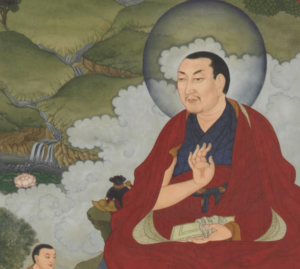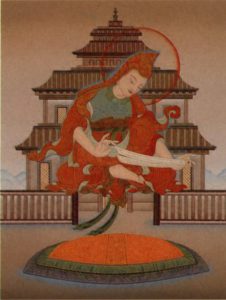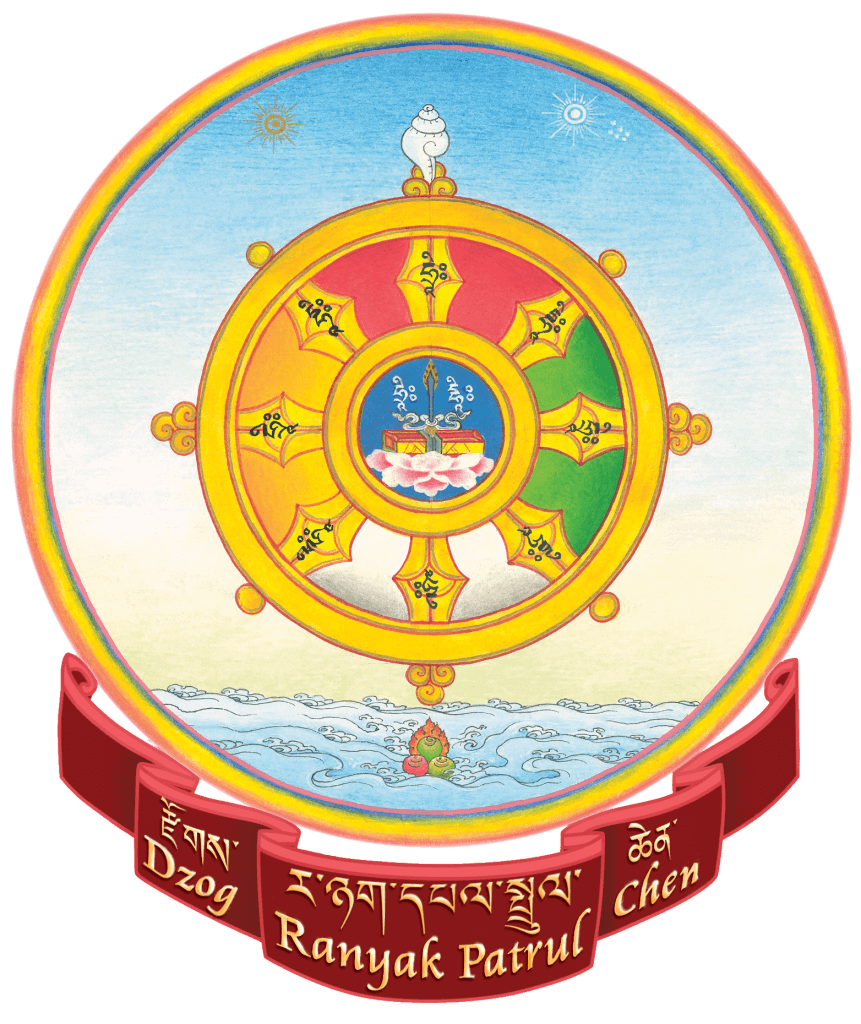General
Buddhist
Studies
General
Buddhist Studies
The General Buddhist Study Courses and Winter Retreats are designed for those who wish to be guided through their study of Buddhism but who do not wish to commit themselves to a programme of continual study and practice, like the Dzogchen Practitioners’ Course.
These study-retreats are open to all. During these courses, Patrul Rinpoche teaches important aspects of Buddhist philosophy and practice.
Are you also interested in weekly courses?
Do you want to know about upcoming retreats?
‘THE WORDS OF MY PERFECT TEACHER’ CYCLE
Composed by the charismatic, wandering master Dza Patrul Rinpoche (1808-1887) in a retreat cave in the Tibetan valley of Dzogchen, The Words of My Perfect Teacher is a quintessential introduction to the spiritual practices common to all Tibetan Buddhist schools, in a unique combination of exceptional profundity and colourful expression. Although it was written for practitioners of the Longchen Nyingthik in the Nyingma tradition, it is directly accessible to the western modern reader who wishes to follow an authentic path to liberation.

First presenting a series of preliminary contemplations on universal notions such as impermanence, karma, suffering and loving kindness, the book addresses then the initial practices of the Vajrayana, all the while emphasising the need for generating and developing compassion as the indispensable condition for achieving enlightenment.
It is this invaluable text which the present Patrul Rinpoche comments in a series of teachings, in his usual gentle and direct manner, enhanced with a wealth of advice drawn from his own experience and thorough understanding of the Dharma.
Rinpoche teaches in English, with translations being provided to Polish, Russian, Japanese, Portuguese and French.
The archives for previous teachings by Patrul Rinpoche on The Words of My Perfect Teacher are available here.
For upcoming teachings on the same text please see the CALENDAR.
Furthermore, Lopön Tsering Gönpo gives a review course on this topic and the archives are available here.
‘BODHICHARYAVATARA’ CYCLE

Written in the 8th century by the great Indian Buddhist master Shantideva, the Bodhicharyavatara (often translated as Introduction to the Bodhisattva’s Way of Life) is one of the most inspiring outlines of the Mahayana path, studied in Buddhist institutions worldwide and praised as well for its poetic qualities as for its spiritual profundity. Central to this path is the generation and cultivation of bodhicitta—the mind of enlightenment, a limitless compassion encompassing all beings without exception.
The Bodhicharyavatara was the text Dza Patrul Rinpoche taught during the greater part of his life to innumerable students, and it is also the text that the present Ranyak Patrul Rinpoche chose to teach in the framework of the Zangdok Palri Institute, thus manifesting the continuity of the compassionate heritage transmitted from master to master. From 1998 through 2009, as well as in 2019, Rinpoche commented during each Winter Retreat on different chapters of this masterpiece. The text has also been taught in other countries e. g. since 2012 annually in Patrul Rinpoche’s centre in Poland.
For the 2019 video recordings of the teachings on the Bodhicharyavatara, see here.
CHRONOLOGY OF GENERAL STUDY COURSES
- In June 2004, for the inauguration of the Zangdok Palri Institute, the General Buddhist Studies Course was based on The Precious Bodhi Tree, a text written by Dzogchen Ranyak Patrul Rinpoche. It was followed by other teachings in order to enrich students’ understanding of diverse aspects of Buddhist wisdom and practice.
- In 2005, Rinpoche taught Advice to Kunzang Chögyal by Dza Patrul Rinpoche.Written by the Great Master Dza Patrul Rinpoche (1808-1887) for his friend and disciple Kunzang Chögyal, this short and incisive text perfectly reflects the unconventional personality and often very pragmatic way of teaching of its author.
Summarising the main points on the path to liberation and their implementation, Dza Patrul Rinpoche formulates the need to tame our minds in a concise and easy to remember way. But he also warns us against the lures that we may encounter on the highway and that we may derail if we are not careful.
- In 2006, Rinpoche started an in-depth study of The Words of My Perfect Teacher. That year the first chapter about “The precious human life” was studied. The course is being continued.
- In 2008, Rinpoche gave a teaching on The Four Noble Truths in Brussels, Belgium.Patrul Rinpoche gave a commentary of The True Words of The Great Rishi, an explanation of the Four Noble Truths written in the style of a root text.
The Four Noble Truths are “the crucial point of the eighty-four thousand teachings, the starting point of the ocean of truthful teachings, the general outline, or summary, of all the sutras and tantras.”
They are “the foundation of all paths, the general outline of all vehicles and the great path of superior individuals. So, it is crucially important for our practice of the Dharma, whether it should be according to the instructions of the sutras or of the tantras, that our knowledge of the meaning of the four truths be perfect.”− The True Words of The Great Rishi
- In 2009, Rinpoche taught Uttaratantra. This retreat was unusual in the sense that it formed the base to launch a third “Dzogchen Practitioners’ Course” starting in 2010. The Uttaratantra (“Gyud Lama”, The Ultimate Continuum), written by the great Indian master Asanga in the 4th century AD, is said to have been dictated by Arya Maitreya, the future Buddha in this world, and can be considered one of the most important texts for Dharma students and practitioners.
Elucidating the Buddha nature present in all beings and explaining extensively its qualities and our inherent potential for enlightenment, this essential treatise provides the grounding for the understanding of the tantric view. Clearly structured and very detailed, it reveals to us the hidden treasure of our awakened nature of mind in order to support us on the path towards its realization. - In 2010, Rinpoche taught the Mulamadhyamaka-karika, or “Uma tsawa sherab” in Tibetan (The Root Stanzas on the Middle Way), in Dzogchen, Tibet and the same summer again in Dharma City, Belgium. The Root Stanzas on the Middle Way, (Mulamadhyamaka-karika, “Uma Tsawa Sherab”) is the key text of the Madhyamaka (Middle Way) school of Buddhism and certainly the most famous work of Nagarjuna, the great Indian philosopher and master of the 2nd century AD. Written in twenty-seven chapters, in a concise style and with rigorous logic, this text questions all our certainties about phenomenal reality and introduces us masterfully to the concept of interdependent arising which is the essence of the Middle Way.
- In 2012, the course took place from 26 to 28 October. The subject was “How to be a good person according to the Buddha”.
- In 2013, Rinpoche taught The Thirty-Seven Practices of the Bodhisattvas, in Dharma City, Belgium.This timeless classic of the great Kadampa master Gyalse Ngulchu Thogme is a concise teaching on training the mind in bodhicitta, the mind of enlightenment—an unbiased compassion encompassing all beings. In only thirty-seven verses, Gyalse Thogme gives a succinct overview of Acharya Shantideva’s renown masterpiece, the Bodhicharyavatara (often translated as Introduction to the Bodhisattva’s Way of Life), an opus that Ranyak Patrul Rinpoche is also keen on teaching.In short, in whatever you are doing,
To always, with mindfulness and attentiveness,
Ask yourself, “What is the state of my mind?”
And accomplish the benefit of others is the practice of a bodhisattva.
—Verse 36
- In 2014, Patrul Rinpoche explained “How to find peace of mind through meditation”, in Dharma City, Belgium.
- In 2018, Patrul Rinpoche initiated a new cycle of teachings introducing all aspects of the practice, following the The Words of My Perfect Teacher.
- 2019 – present, the seminars on the The Words of My Perfect Teacher remain open to all but can also be taken as a gradual course with exams. All teachings archives of this cycle are on YouTube.
CHRONOLOGY OF WINTER RETREATS
Every year, between Christmas and New-Year, Patrul Rinpoche guides a retreat that ends on New Year’s Eve with a cheerful celebration.
- 1998-2009, 2013, 2019: Bodhicharyavatara, Introduction to the Bodhisattva’s Way of Life, by Shantideva
Written in the 8th century by the great Indian Buddhist master Shantideva, the Bodhicharyavatara (often translated as Introduction to the Bodhisattva’s Way of Life) is one of the most inspiring outlines of the Mahayana path, studied in Buddhist institutions worldwide and praised as well for its poetic qualities as for its spiritual profundity. Central to this path is the generation and cultivation of bodhicitta—the mind of enlightenment, a limitless compassion encompassing all beings without exception.
The Bodhicharyavatara was the text Dza Patrul Rinpoche taught during the greater part of his life to innumerable students, and it is also the text that the present Ranyak Patrul Rinpoche chose to teach in the framework of the Zangdok Palri Institute, thus manifesting the continuity of the compassionate heritage transmitted from master to master. From 1998 through 2009, as well as in 2019, Rinpoche commented during each Winter Retreat on different chapters of this masterpiece. The text has also been taught in other countries e. g. since 2012 annually in Patrul Rinpoche’s centre in Poland.
For the 2019 video recordings of the teachings on the Bodhicharyavatara see here.
Chronology:
- 1998: 1st chapiter of The Bodhisattva’s Way of Life
- 1999: 2nd chapiter of The Bodhisattva’s Way of Life
- 2000: 3rd chapiter of The Bodhisattva’s Way of Life
- 2001: 4th chapiter of The Bodhisattva’s Way of Life
- 2002: 5th chapiter of The Bodhisattva’s Way of Life
- 2004: 6th chapiter of The Bodhisattva’s Way of Life
- 2005: 7th chapiter of The Bodhisattva’s Way of Life
- 2006: 8th chapiter of The Bodhisattva’s Way of Life
- 2007: 9th chapiter (start) of The Bodhisattva’s Way of Life
- 2008: 9th chapiter (continuation) of The Bodhisattva’s Way of Life
- 2009: 3rd chapiter of The Bodhisattva’s Way of Life
- 2012: How to meditate on the Great Emptiness according to the Wisdom Chapter of The Bodhisattva’s Way of Life
- 2019: 1st chapiter of The Bodhisattva’s Way of Life
- 2003: Kuntuzangpo Aspiration Prayers
- 2010: The Precious Bodhi Tree, by Ranyak Patrul Rinpoche
- 2011: The Six Bardos
- 2013: Rigdzin Dupa Sadhana, Explanations by Khenpo Thubten Lodru Nyima
- 2014: The Heart-Essence: Advice on Two Ethics, by Dza Patrul Rinpoche
- 2015: Advice from me to myself, by Dza Patrul Rinpoche
- 2016: The Thirty-Seven Practises of a Bodhisattva, by Gyalse Ngulchu Thogme
This timeless classic of the great Kadampa master Gyalse Ngulchu Thogme is a concise teaching on training the mind in bodhicitta, the mind of enlightenment—an unbiased compassion encompassing all beings. In only thirty-seven verses, Gyalse Thogme gives a succinct overview of Acharya Shantideva’s renowned masterpiece, the Bodhicharyavatara (often translated as Introduction to the Bodhisattva’s Way of Life), an opus that Ranyak Patrul Rinpoche is also keen on teaching.
In short, in whatever you are doing,
To always, with mindfulness and attentiveness,
Ask yourself, “What is the state of my mind?”
And accomplish the benefit of others is the practice of a bodhisattva.
—Verse 36
- 2017: Ladder to Akanistha by Jigme Lingpa, and Clarifying the Difficult Points by Patrul Chökyi Wangpo
- 2018: An Instruction on the View of the Mahayana: Clarifying the Two Truths, by Dza Patrul Rinpoche
- 2019: Bodhicharyavatara, Introduction to the Bodhisattva’s Way of Life, by Shantideva—new cycle of expounding this text in Palgué Nyishar Ling retreat centre (Portugal)
- 2020: The Words of My Perfect Teacher, by Dza Patrul Rinpoche (in the continuity of the corresponding teaching cycle)
- 2022: How to put the Great Perfection into practice, by Patrul Rinpoche (Dharma City, Belgium)
OTHER TEACHINGS
While the Words of My Perfect Teacher and the Bodhicharyavatara are recurring teaching cycles,
Patrul Rinpoche has expounded a variety of different topics since 1998, both during the General Buddhist Study Courses and Winter Retreats. These topics range from general subjects, such as the Four Noble Truths, to profound pith instructions on the true nature of the mind. Discover the entire list in the Chronology of the General Study Courses and Winter Retreats below.
